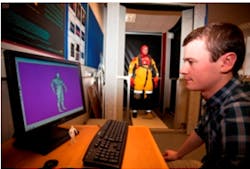Offshore workers scanned in 3-D
Researchers at Robert Gordon University (RGU; Aberdeen, UK) are to measure offshore workers' body size with 3-D scanners to inform the future design of safety equipment, survival clothing and space requirements on offshore installations.
The research is the first of its kind in more than 25 years and is being led by researchers at Robert Gordon University's Institute of Health and Welfare Research (IHWR) in collaboration with experts from Oil and Gas UK.
Six hundred off-shore workers will be scanned during the course of the study. The data will then be used to inform all aspects of offshore ergonomics and health and safety, from emergency helicopter evacuation and survival suit design to space availability in corridors and work environments.
"The last body size survey of offshore workers was undertaken in the mid 1980s and since then the average weight of the workforce has risen by 19 per cent. As a consequence the size and shape of the offshore workforce has increased to an unknown level," says project leader Dr. Arthur Stewart, the deputy director of RGU's Centre for Obesity Research and Epidemiology.
More than £150,000 in funding for the project was secured through a combination of a Technology Strategy Board Knowledge Transfer Partnership Grant as well as support from several Oil and Gas UK member companies.
Related articles from Vision Systems Design that you might also find of interest.
1. 3-D modeling improves spinal casting process
Engineers at 4DDynamics have developed a 3-D system that can be used to develop prosthetic corsets in less than half a day.
2. 3-D scanner helps create Man of Steel
Engineers at Sheffield Hallam University (Sheffield, UK) have played a crucial role in the development of a proposed landmark sculpture called the Man of Steel for the Sheffield city region.
3. Digitizer captures 3-D images at fast data rates
Many different techniques currently exist to digitize three-dimensional objects, each of which has its own advantages. One common method uses a structured laser light that is projected across the field of view of the part to be imaged.
-- Dave Wilson, Senior Editor, Vision Systems Design
